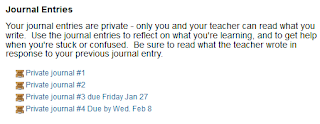Three big differences. First, the already-mentioned 7th grade enthusiasm for using online / Moodle for communications (even though they see each other daily). Boys and girls used Moodle discussions at about the same rates.
Second difference, 7th grade students are reading faster. In the past, I’ve given students about 2 ½ to 3 weeks to read their books, and many have needed every single day. Lately, I’ve been hearing, “Can we get a new book? We finished ours already,” from the 7th grade. The 8th graders enjoy the project, but take a more blasé attitude. They finish the book and write reflections after they’ve finished. The 7th graders seem to prefer to keep on reading. On the other hand, I’ve had quite a number of “non-reader” 8th graders who have begged for us to do more two-way journals, “so we can read the next book in that series.” And 8th graders don’t have time set aside for reaching, while 7th graders still do.
Third difference, students are writing more, and writing in more depth. In most cases, I’m seeing deeper thinking. This is only the second two-way journal that the 7th graders have done. But boy do they get it. And are they into it! They’re even referring to things they learned in other classes. I’m seeing this across the spectrum of reading ability; with 8th graders, I see more of what I can only call “dancing on the surface.” 8th grade is more about being cool; 7th graders can’t manage that yet.
Two 7th grade pairs selected a book they decided they hated after just a few days of reading – Canned. Could they please, please change? Of course! I want them to find a book they’d rather read because then they’ll read. One pair selected New Boy. The other chose One Fat Summer. And they’re off and running. (The 8th graders when they didn’t particularly like the book, persevered. Too much trouble to find a new book?) It does help to have hundreds of books for them to choose from.
I’m curious to see how these 7th graders will use two-way journals next year when they are in 8th grade. Will they take a step back? Be less enthusiastic? I’ll need to find a way to make two-way journals become fresh for them – maybe require them to add images to their words, something the 7th graders occasionally do already without prompting.

